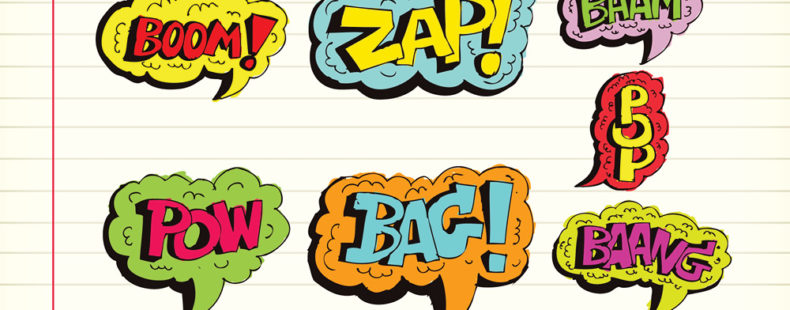Few words are as fun to say as onomatopoeia, but what the heck does it mean?
Despite its complex look and sound, onomatopoeia actually has a simple function in the English language. It’s defined as “the formation of a word, as cuckoo, meow, honk, or boom, by imitation of a sound made by or associated with its referent.”
To put it simply, it’s a word that sounds like what it means.
WATCH: What Kind Of Words Are Onomatopoeia?
Onomatopoeia in the wild
Recorded in English by the late 1500s, the word onomatopoeia comes from onomatopoiía, which is Greek for “the making of words.” In Greek, ónoma means “name” and poi comes from poieîn, that is, “to make.”
Most people’s first experiences with onomatopoeia actually come from television. You might recall a certain 1960s version of Batman, in which the sounds of his fights appeared on the screen in brightly colored pop-up bubbles. Bam! Pow! Zap!
But, Batman wasn’t the only television character to make use of onomatopoeia. Shaggy from Scooby-Doo famously said, “Zoinks!” whenever he was scared. Looney Tunes characters signify drinking with glug, glug, glug. In real life, we use onomatopoeia for all sorts of sounds. Cats meow, cash registers go ka-ching, shoes squeak, birds chirp, pigs oink, and bored humans go pffffft.
Why do we use onomatopoeia?
Perhaps the most fascinating thing about onomatopoeia is that it exists all over the world. It is not a uniquely American or English thing to make words from sounds. As journalist Uri Friedman notes in The Atlantic, “in Swedish, the sound of a small dog barking is rendered as bjäbb-bjäbb; in Turkish, hev hev; in Japanese, kian kian.” (In fact, we have a whole article about this if you want to know more.) Many cultures have their own words that imitate common sounds. Some linguists even theorize that language itself evolved from humans trying to imitate sounds in the natural world.
There are words in the English language that may not look to us like onomatopoeia, but could be. The word owl, for instance, was first recorded in English before the year 900 as the Middle English oule, pronounced oo-lay, which may have come from an attempt to mimic the owl’s hoot. Similarly, the word laugh comes from the Middle English laughen, which is believed to be closely related to the German lachen, the Old Norse hlǣja, and the Gothic hlahjan, all of which are thought to represent the sound of laughter.
Even though English is an established language, we’re still making new onomatopoeic words. Consider the untz-untz that many of us use to signify the beat of popular music, the pew-pew we associate with the sound of lasers, or the tap of someone typing out a text message on their phone. As long as humans have new sounds to discover, we will continue to create new words to describe those sounds.
And, just for fun, here’s some more onomatopoeia you likely use every day without even realizing it: You zip your pants before you head out the door to work every morning. Your phone pings to let you know you have a new email or you ping your coworker when you need to ask them a question. You giggle at the meme your bestie just texted to you. Fresh, hot coffee drips from the Keurig machine as you munch on avocado toast.














